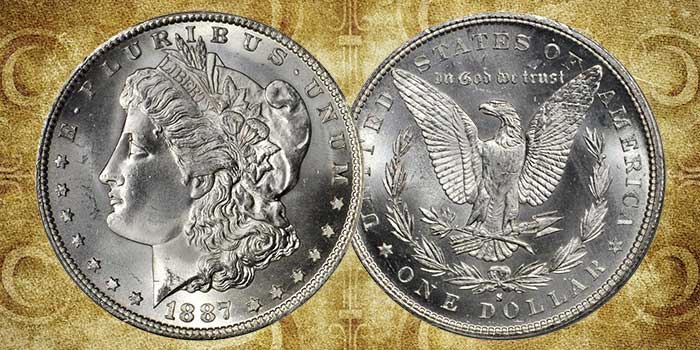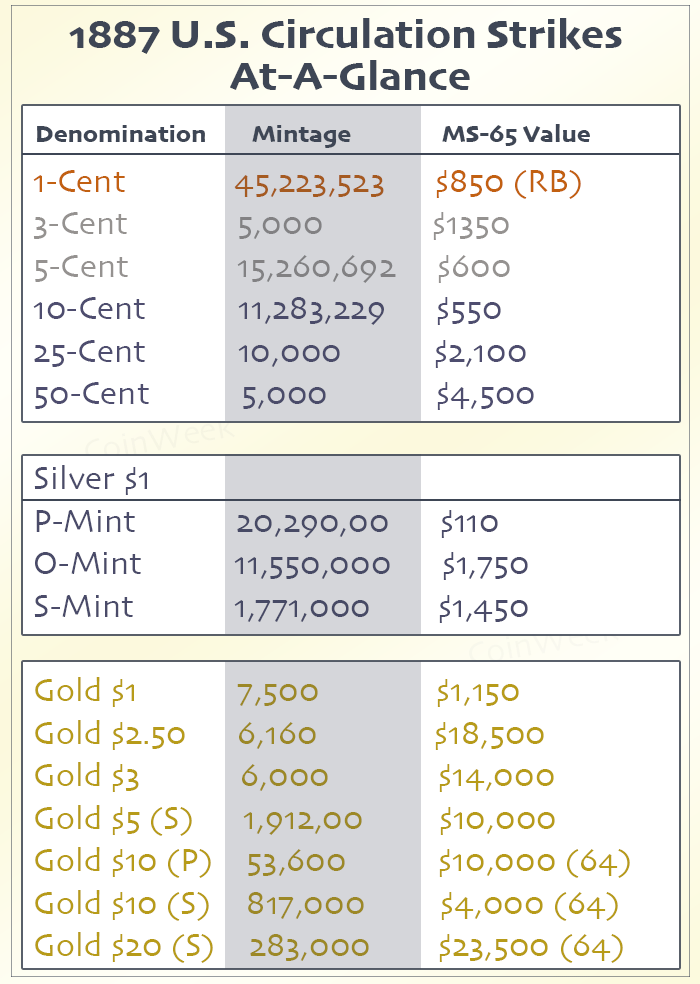
The 1887-S Morgan dollar, known more officially as the Liberty Head dollar, is a silver coin that was struck at the San Francisco branch of the United States Mint. The San Francisco Mint struck 1,771,000 Morgan dollars in 1887 and a majority of all of the U.S. gold coins struck during the year.
Production of the 1887-S Morgan dollar began in June but continued in earnest from July through the end of the year with monthly output peaking at 450,000 pieces delivered in August.
A scarce issue, most 1887-S Morgan dollars entered into circulation and the lion’s share was distributed before the Treasury Vaults were emptied by speculators in the early 1960s. The Redfield Hoard, which was broken up starting in 1976, contained a few hundred pieces in various states of preservation.
In circulated grades, sufficient numbers of 1887-S Morgan dollars survive today to satisfy collector demand, but the coin is scarce in Mint State and rare in grades MS66 and above. While many original uncirculated examples exhibit satin surfaces, a number of Prooflike and Deep Mirror Prooflike examples survive as well. An exceptional example graded MS65DMPL by PCGS from the Jack Lee 2 Collection brought $25,300 at a November 2005 Heritage Auction.
The Morgan dollar gets its name from United States Mint engraver George T. Morgan, who designed the dollar coin in competition with then-Chief Engraver William Barber. The two had a generally cordial relationship, though numismatists throughout the generations have supposed that Barber may have been envious of Morgan’s talent as an engraver and treated him with some degree of unprofessionalism. This is not true.
Morgan was born in England and began working for the Mint soon after his arrival in the United States in 1876. Morgan was brought on as an assistant engraver in October 1876 and then worked under William Barber. In addition to the Liberty Head dollar, Morgan has several coin design credits to his name, including the Columbian half dollar of 1892 and 1893, and an array of pattern coins designed during the late 19th century, most notable of these being the never-released $100 Gold Union coin.
Design
Obverse:
The obverse of the 1887-S Morgan dollar exhibits the characteristic left-facing Liberty Head motif seen on all issues of this classic dollar series. The central Liberty bust wears a Phrygian cap encircled with a ribbon adorned with the inscription LIBERTY. Miss Liberty also wears a crown of wheat and cotton, which were two of the nation’s most lucrative natural agricultural assets in the 19th century.
The phrase E PLURIBUS UNUM is inscribed along the upper half of the obverse rim, and the date 1886 is centered at the bottom of the obverse adjacent to the rim. Seven stars appear between the left side of the date and the inscription E PLURIBUS UNUM, while six stars fill the gap between the date and motto on the lower right side of the coin. In total, the 13 stars represent the 13 colonies that combined to form the original Union of the United States. At the base of Liberty’s neck is the “M” monogram representing Morgan’s initial.
Morgan designed the Liberty head bust after the likeness of Anna Willess Williams, a Philadelphia schoolteacher who modeled for the coin. Williams received significant public recognition after her face appeared on the Morgan dollar, but she rejected the attention that was heaped upon her. She refused offers for acting roles and apparently had turned down an offer for marriage following her engagement to an unknown suitor. Before dying at the age of 68 in 1926, Williams, who sat for Morgan on the sworn condition of anonymity, rebuffed her single stint as a coin design model as little more than an “incident of my youth”.
Reverse:
 The reverse of the 1887-S Morgan dollar is dominated by a heraldic eagle, its wings spread across the upper half of the coin. Between the upper tips of the eagle’s wings appears the motto IN GOD WE TRUST. The eagle clutches an olive branch in its right claw representing peace and in its left claw are three arrows symbolizing the nation’s ability to defend itself. The central eagle design is partly encircled by a laurel wreath.
The reverse of the 1887-S Morgan dollar is dominated by a heraldic eagle, its wings spread across the upper half of the coin. Between the upper tips of the eagle’s wings appears the motto IN GOD WE TRUST. The eagle clutches an olive branch in its right claw representing peace and in its left claw are three arrows symbolizing the nation’s ability to defend itself. The central eagle design is partly encircled by a laurel wreath.
Along the rim of the upper two-thirds of the reverse is the legend UNITED STATES OF AMERICA, with the tip of the eagle’s left wings, which virtually touch the coin’s rim, penetrating the space between UNITED and STATES; the right wing visually divides the words OF and AMERICA. The words ONE DOLLAR, seen at the bottom center of the reverse, are flanked by a single, six-sided star on either side of the denomination inscription. The “S” mintmark, denoting that the coin was struck at the San Francisco Mint, is located above the DO of DOLLAR.
Edge:
The edge of the 1887-S Morgan dollar is reeded.
Designer
Engraver George T. Morgan was born in Birmingham, England in 1845. He emigrated to the United States and began work as an assistant to Mint Chief Engraver William Barber and continued to produce patterns and commemoratives under the administration of Barber’s son, Charles. Morgan himself became Chief Engraver in 1917. He died in 1925.
U.S. Circulating Coin Production in 1887 – The Morgan Dollar in Context

In 1887, the Philadelphia Mint handled U.S. coin production for all minor denominations, the silver dollar, and gold denominations up to $10 (with the exception of the half eagle, which was only struck for circulation at the San Francisco branch).
The table to the right illustrates current market levels relative to mintages in the grade of MS65. There are no “Gem” 65 coins known at present for the $10 and $20 denominations, so we substituted in the MS64 value.
Building a complete 1887 year set of circulation strikes in Gem or finest known 64s will set a collector back about $100,000 USD. However, this pursuit is well within the means of most interested adult collectors in the grade of MS62 or MS63. We estimate a choice set to cost about 1/4 to 1/3 of that price.
If you were only concerned about Morgan dollars, the 1887-S is much scarcer in Gem than the plentiful Philadelphia Mint issue (which retails for just over $100 in MS65) and nearly on par with the 1887-O. It’s interesting that the 1887-S has such a lower mintage than the 1887-O but is actually worth less money in Gem Mint State. This is due to the fact that far fewer Gem 1887-O Morgan dollars have been preserved than the issue’s mintage of 11,550,000 coins might suggest. The New Orleans coins also tend to exhibit lower strike quality than the San Francisco issues.
In terms of the 1887 date and mint set, the 1887-S Morgan trails behind the 1887-O dollar, the 1887 quarter, and the 1887 half dollar in terms of silver coin scarcity.
Coin Specifications
| Country: | United States |
| Year Of Issue: | 1887 |
| Denomination: | 1 Dollar |
| Mint Mark: | S (San Francisco) |
| Mintage: | 1,771,000 |
| Alloy: | 90% Silver, 10% Copper |
| Weight: | 26.73 grams |
| Diameter: | 38.10 mm |
| Edge | Reeded |
| OBV Designer | George T. Morgan |
| REV Designer | George T. Morgan |
| Quality: | Business Strike |




